EtherCAT timestamp: high-precision interaction of controller and environment – to the exact nanosecond
EtherCAT's own Distributed Clocks system allows the time-based operation of input or output modules independently of the EtherCAT cycle. Switching operations of outputs or the reading of inputs can thus be controlled by timestamp.
More about this video
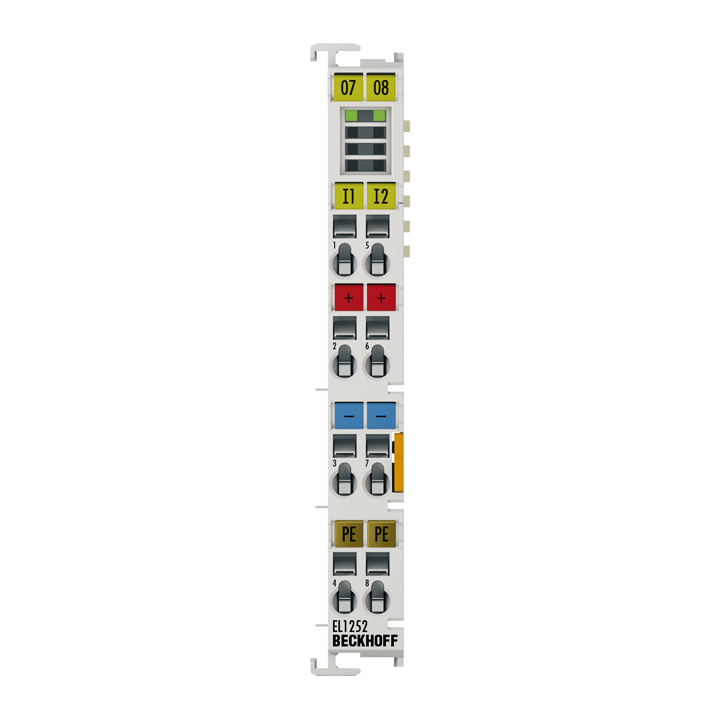
EL1252 | EtherCAT Terminal, 2-channel digital input, 24 V DC, 1 µs, timestamp
The EL1252 digital input terminal acquires the fast binary 24 V control signals from the process level and transmits them, in an electrically isolated form, to the controller. The EtherCAT Terminal contains two channels whose signal state is indicated by LEDs. The signals are furnished with a time stamp that identifies the time of the last edge change with a resolution of 1 ns. With this XFC technology, signal characteristics can be traced exactly in time and correlated with the distributed clocks system-wide. With this technology, machine-wide parallel hardware wiring of digital inputs or encoder signals for synchronization purposes is often no longer required. In conjunction with the EL2252 EtherCAT Terminal (digital output terminal with time stamp), the EL1252 enables responses with equidistant time intervals, largely independent of the bus cycle time.
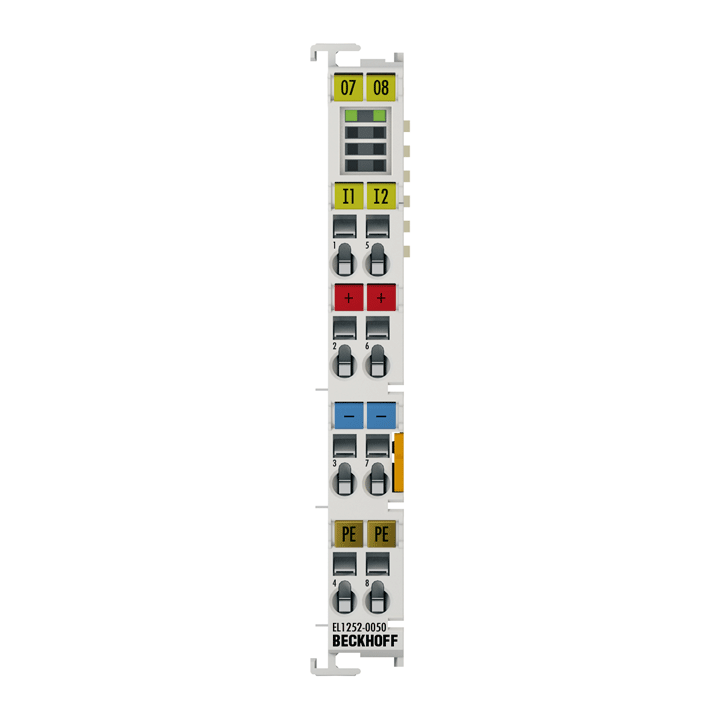
EL1252-0050 | EtherCAT Terminal, 2-channel digital input, 5 V DC, 1 µs, timestamp
The EL1252-0050 digital input terminal acquires the fast binary 5 V control signals from the process level and transmits them, in an electrically isolated form, to the controller. The EtherCAT Terminal has two channels that indicate their signal state via light emitting diodes. The signals are furnished with a time stamp that identifies the time of the last edge change with a resolution of 1 ns. With this XFC technology, signal characteristics can be traced exactly in time and correlated with the distributed clocks system-wide. With this technology, machine-wide parallel hardware wiring of digital inputs or encoder signals for synchronization purposes is often no longer required. The switching thresholds of the input circuit are based on the CMOS level: Signal voltage "0" < 0.8 V, signal voltage "1" > 2.4 V. The 5 V supply voltage can be generated by the EL9505 power supply terminal and fed into the power contacts.
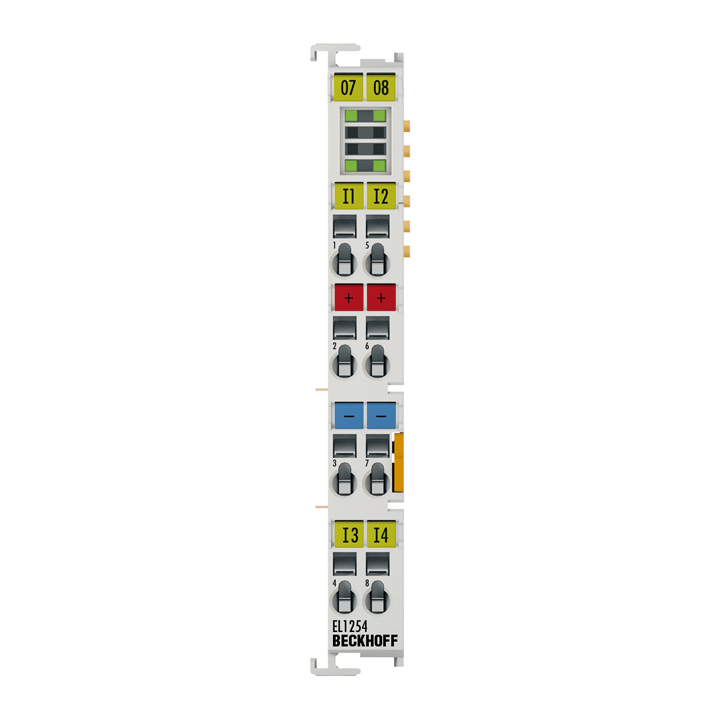
EL1254 | EtherCAT Terminal, 4-channel digital input, 24 V DC, 1 µs, timestamp
The EL1254 digital input terminal acquires the fast binary 24 V control signals from the process level and transmits them, in an electrically isolated form, to the controller. The EtherCAT Terminal has four channels that indicate their signal state via light emitting diodes. The signals are furnished with a time stamp that identifies the time of the last edge change with a resolution of 1 ns. With this XFC technology, signal characteristics can be traced exactly in time and correlated with the distributed clocks system-wide. With this technology, machine-wide parallel hardware wiring of digital inputs or encoder signals for synchronization purposes is often no longer required.
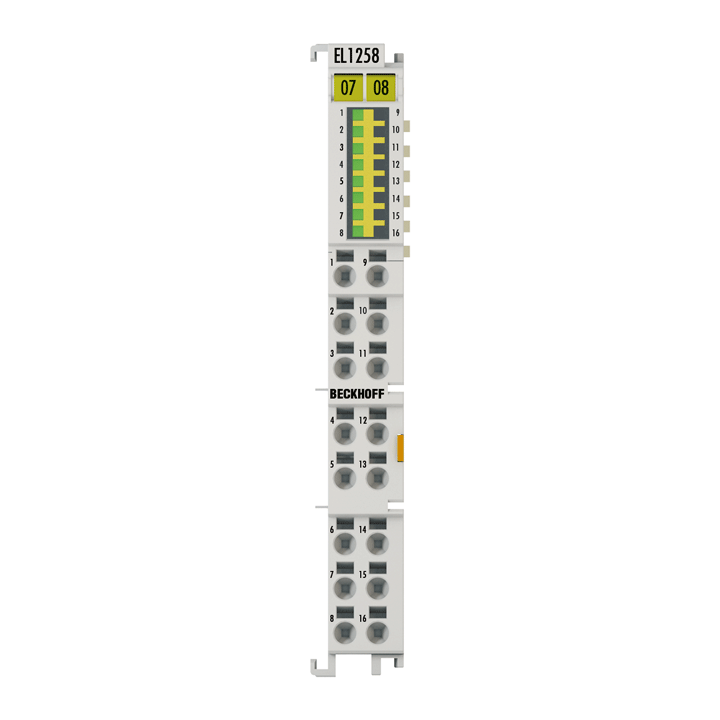
EL1258 | EtherCAT Terminal, 8-channel digital input, 24 V DC, 1 µs, multi-timestamp
The EL1258 digital input terminal acquires the fast binary 24 V control signals from the process level and transmits them, in an electrically isolated form, to the controller. Each EtherCAT Terminal has eight channels that indicate their signal state via light emitting diodes. In comparison with the EL1252, the EL1258 offers not only a higher channel density, but also a higher performance thanks to the XFC multi-timestamp function. Whereas the EL1252 can accept one edge change with time stamp per bus cycle, the EL1258 offers the possibility to register up to 32 events with time stamps. The EL1258 is synchronized with other EtherCAT devices through the distributed clocks system, so that events in the whole system can be measured with a uniform timebase.
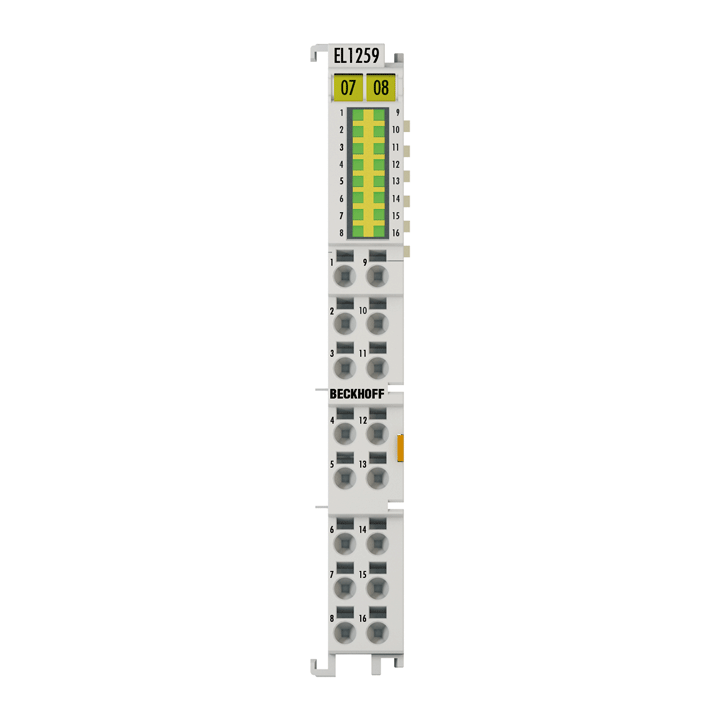
EL1259 | EtherCAT Terminal, 8-channel digital input + 8-channel digital output, 24 V DC, 1 µs, 0.5 A, multi-timestamp
The 16-channel EL1259 digital EtherCAT Terminal combines the functions of the EL1258 – eight multi-timestamp inputs – with those of the EL2258 – eight multi-timestamp outputs. The high channel density in conjunction with time stamping of the signals enables fast, efficient processes through optimized sensor and actuator control. The EL1259 is also synchronized with other devices through the distributed clocks system, so that events in the whole system can be measured with a uniform timebase. The combination of DC-switched inputs and outputs within one terminal can be used for local switching tasks.
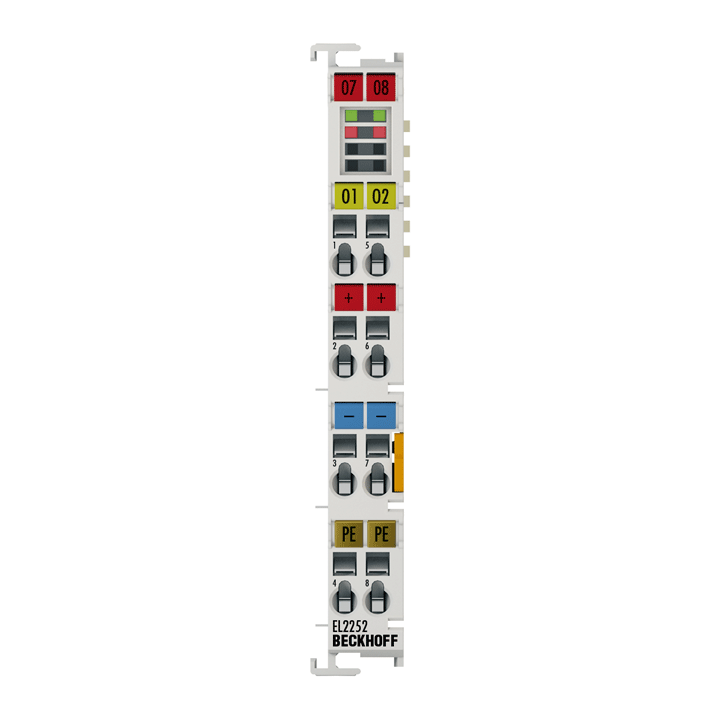
EL2252 | EtherCAT Terminal, 2-channel digital output, 24 V DC, 0.5 A, timestamp
The EL2252 digital output terminal connects the binary control output signals at the process level with electrical isolation. The outputs of the EtherCAT Terminal are switched with high precision to match the transferred timestamp, which has a resolution of 10 ns. This technology enables output switching times to be specified precisely across the system. The distributed clocks are used for reference. In conjunction with the EL1252 (digital input terminal with time stamp), the EL2252 enables responses with equidistant time intervals, largely independent of the bus cycle time. Each output can be switched to high resistance individually.
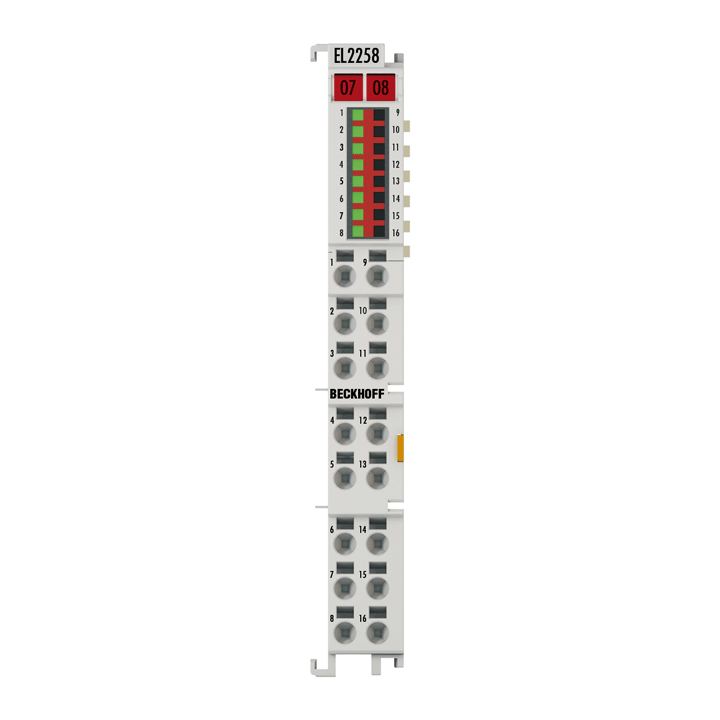
EL2258 | EtherCAT Terminal, 8-channel digital output, 24 V DC, 0.5 A, multi-timestamp
The 8-channel digital output terminal EL2258 connects the binary output signals of the controller at the process level with electrical isolation. As in the EL2252, the outputs of the EL2258 are switched with high precision relative to the transferred time stamp, although there are certain differences in the details: Eight instead of two channels, lower timestamp resolution and auto-activation, which enables consecutive switching tasks in each cycle. The multi-timestamping feature allows each EtherCAT cycle to capture or output as many events per channel as were preloaded in the internal buffer.
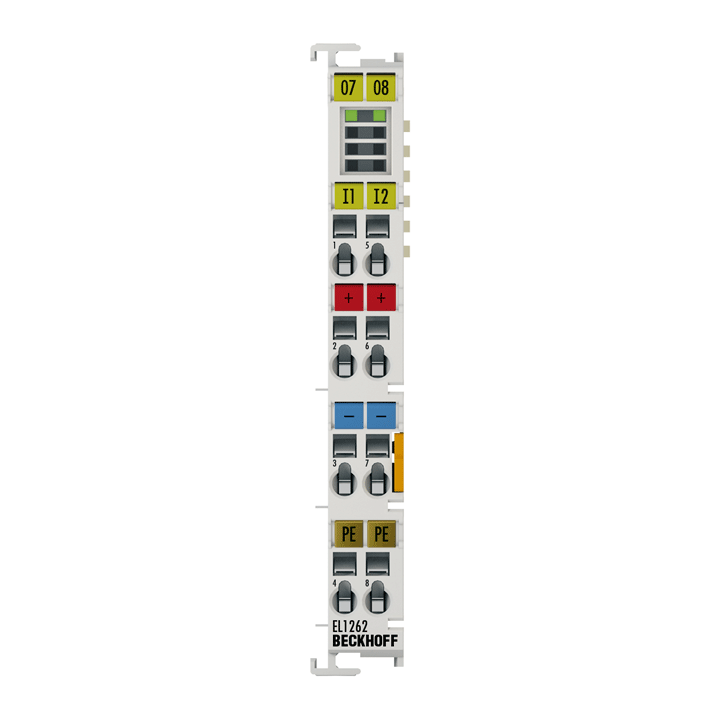
EL1262 | EtherCAT Terminal, 2-channel digital input, 24 V DC, 1 µs, oversampling
The EL1262 digital input terminal acquires the fast binary 24 V control signals from the process level and transmits them, in an electrically isolated form, to the controller. The EtherCAT Terminal has two channels that indicate their signal state via light emitting diodes. The signals are sampled with a configurable, integer multiple (oversampling factor: n) of the bus cycle frequency (n microcycles per bus cycle). For each bus cycle, the EtherCAT Terminal generates a process data block that is transferred collectively during the next bus cycle. The timebase of the terminal can be synchronized precisely with other EtherCAT devices via distributed clocks. This XFC procedure enables the temporal resolution of the digital input signals to be increased to n times the bus cycle time.
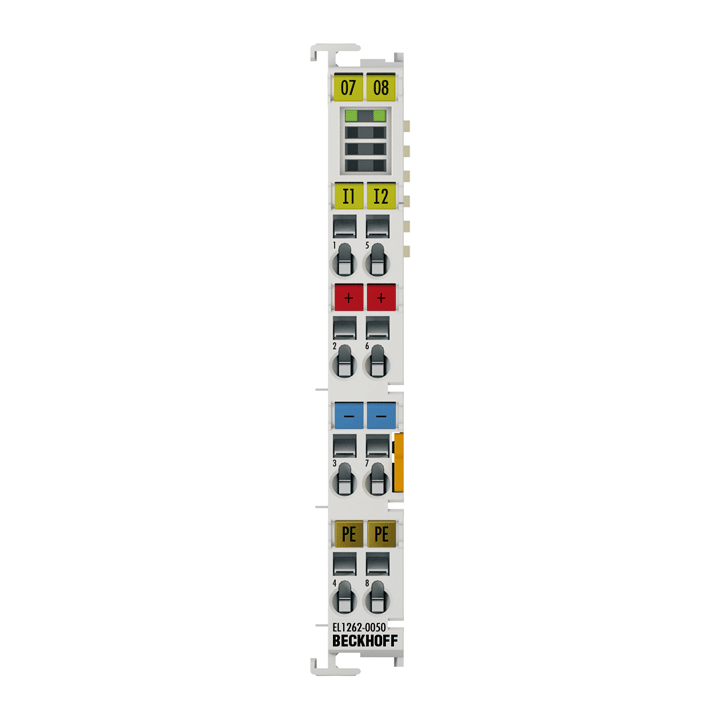
EL1262-0050 | EtherCAT Terminal, 2-channel digital input, 5 V DC, 1 µs, oversampling
The EL1262-0050 digital input terminal acquires the fast binary 5 V control signals from the process level and transmits them, in an electrically isolated form, to the controller. The EtherCAT Terminal has two channels that indicate their signal state via light emitting diodes. The signals are sampled with a configurable, integer multiple (oversampling factor: n) of the bus cycle frequency (n microcycles per bus cycle). For each bus cycle, the EtherCAT Terminal generates a process data block that is transferred collectively during the next bus cycle. The timebase of the terminal can be synchronized precisely with other EtherCAT devices via distributed clocks. This XFC procedure enables the temporal resolution of the digital input signals to be increased to n times the bus cycle time. The switching thresholds of the input circuit are based on the CMOS level: Signal voltage "0" < 0.8 V, signal voltage "1" > 2.4 V. The 5 V supply voltage can be generated by the EL9505 power supply terminal and fed into the power contacts.
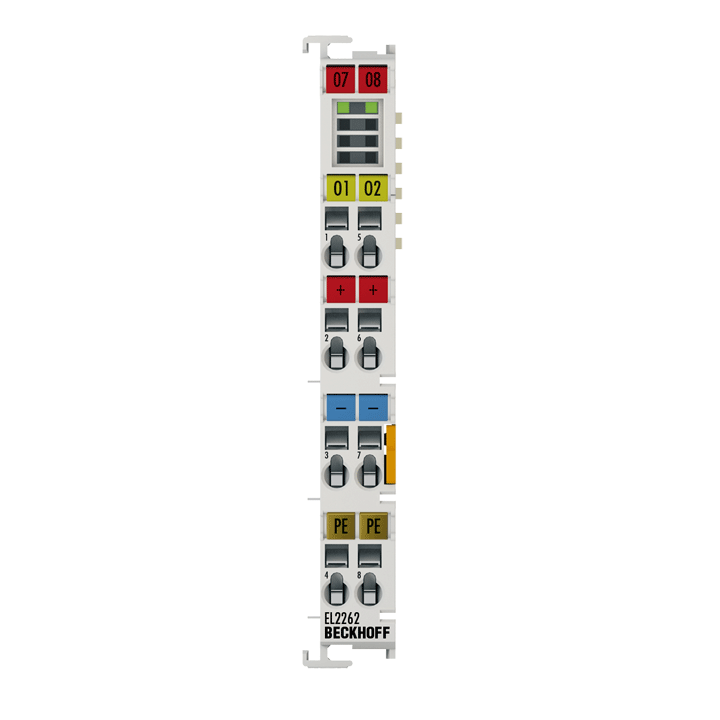
EL2262 | EtherCAT Terminal, 2-channel digital output, 24 V DC, 0.5 A, oversampling
The EL2262 digital output terminal connects the binary control output signals at the process level with electrical isolation. The outputs are controlled with an adjustable integral multiple (oversampling factor: n) of the bus cycle frequency (n microcycles per bus cycle). For each bus cycle, the EtherCAT Terminal receives a process data block that is output consecutively. The timebase of the terminal can be synchronized precisely with other EtherCAT devices via distributed clocks. An output pattern with a significantly higher pulse sequence than the bus cycle time is thus output precisely with the system-wide timebase. This procedure enables the temporal resolution of the digital output signals to be increased to n times the bus cycle time. The maximum output rate is 1 Msamples/s.
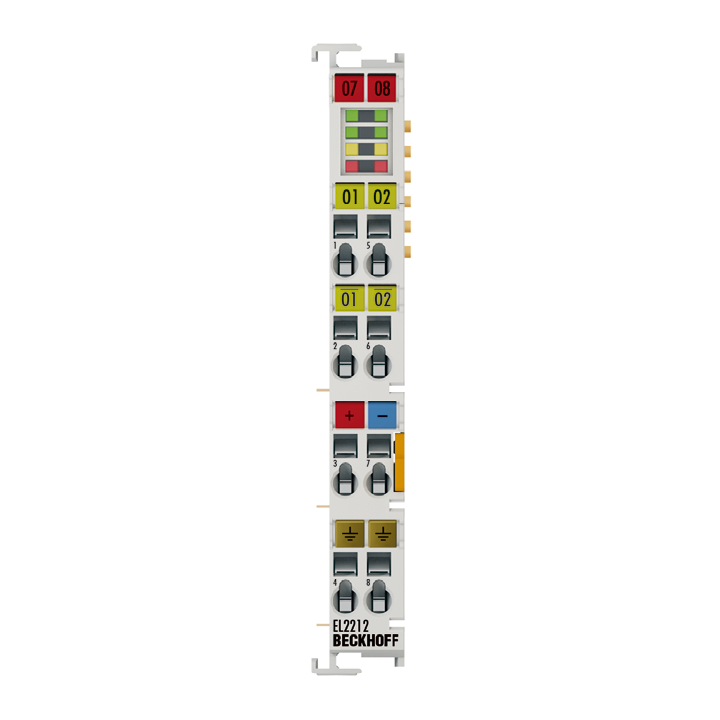
EL2212 | EtherCAT Terminal, 2-channel digital output, 24…72 V DC, 10 A, overexcitation, multi-timestamp
The EL2212 digital output terminal connects the binary control signals from the automation device on to the actuators at the process level with electrical isolation. The multi-timestamp features allow each EtherCAT cycle to capture as many events per channel as were preloaded in the internal buffer.
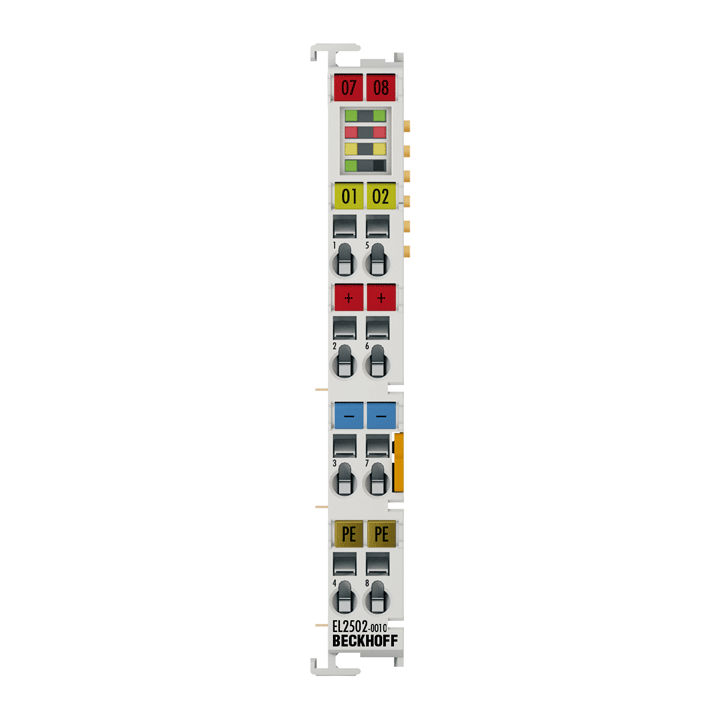
EL2502-0010 | EtherCAT Terminal, 2-channel PWM output, 24 V DC, 0.5 A, timestamping
The EL2502-0010 output terminal modulates the pulse width of a binary signal, and outputs it electrically isolated from the E-bus. The mark/space ratio is preset by a 16-bit value from the automation device. The output stage is protected against overload and short-circuit. The EtherCAT Terminal contains two channels whose signal state is indicated by LEDs. The LEDs are driven in time with the outputs, and show the duty factor by their brightness. The EL2502-0010 supports EtherCAT distributed clock timestamps in order to influence switching on, off and over of a PWM signal with microsecond precision.
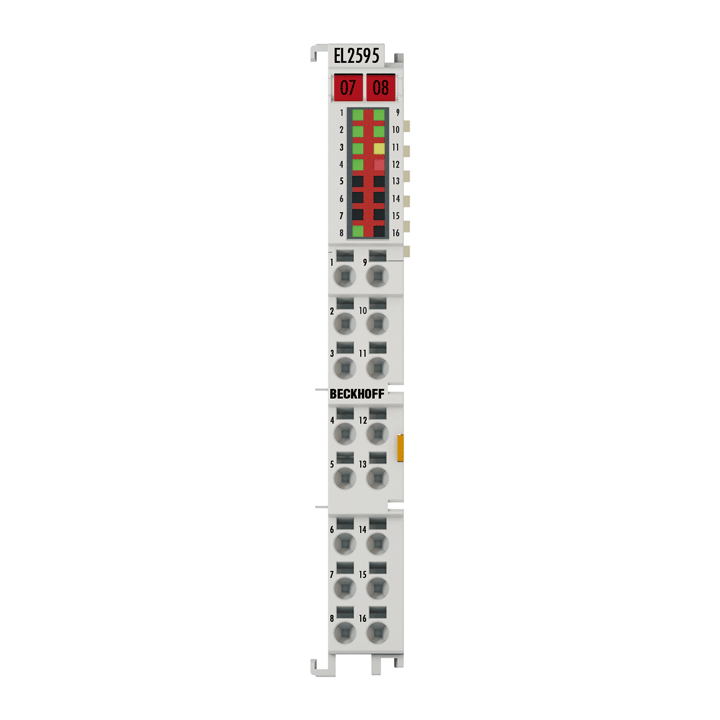
EL2595 | EtherCAT Terminal, 1-channel LED output, 2…48 V DC, 0.7 A
The EL2595 EtherCAT Terminal contains a constant current source for LEDs and is designed to control one or more LEDs connected in series. The user specifies the required set current, the integrated power supply unit then provides the required forward voltage, depending on the connected LEDs. For this purpose, the EL2595 has a step-up/step-down power supply unit, which generates the output voltage from the 24 V DC input voltage. The output voltage is also adjusted during operation in order to maintain the set current. The current can be switched quickly for short-term lighting, hence even extremely short flashes of light are possible. The pulse duration is adjustable from 1 µs to infinity, the flash time itself can be set through a timestamp via distributed clocks; an external trigger input is also available. Extensive real-time diagnostics, e.g. for input current/voltage and output current/voltage allow detailed monitoring of the LED light intensity. If a specifiable load corridor is exited, e.g., due to load errors, the EL2595 switches off to protect the load (resettable).
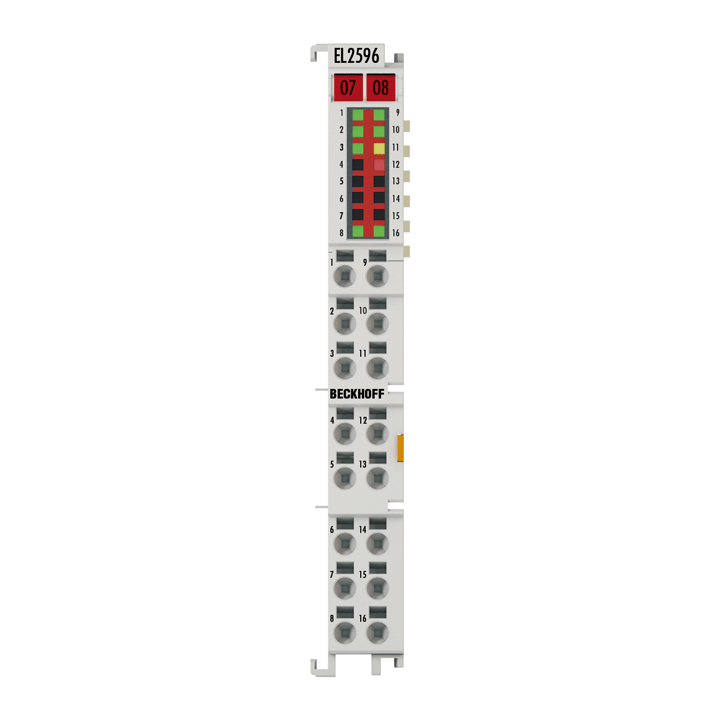
EL2596 | EtherCAT Terminal, 1-channel LED output, 0…24 V DC, 3 A
The EL2596 LED strobe control terminal contains a flexible power supply unit that supplies the LED with the required current and voltage. Applications from continuous light to short light pulses in the kHz range are thus possible. Each individual flash can be triggered in a controlled manner by the control system via the distributed clocks/timestamp function. The EL2596 has a trigger output for triggering cameras and high-quality, fast current and voltage control, so that line scan cameras, for example, also benefit from constant illumination. Extensive real-time diagnostics, e.g. for input current/voltage and output current/voltage allow detailed monitoring of the LED light intensity. Thus, overdrive applications with short high-current pulses through the LED are possible. If a specifiable load corridor is exited, e.g., due to load errors, the EL2596 switches off to protect the LED (resettable).
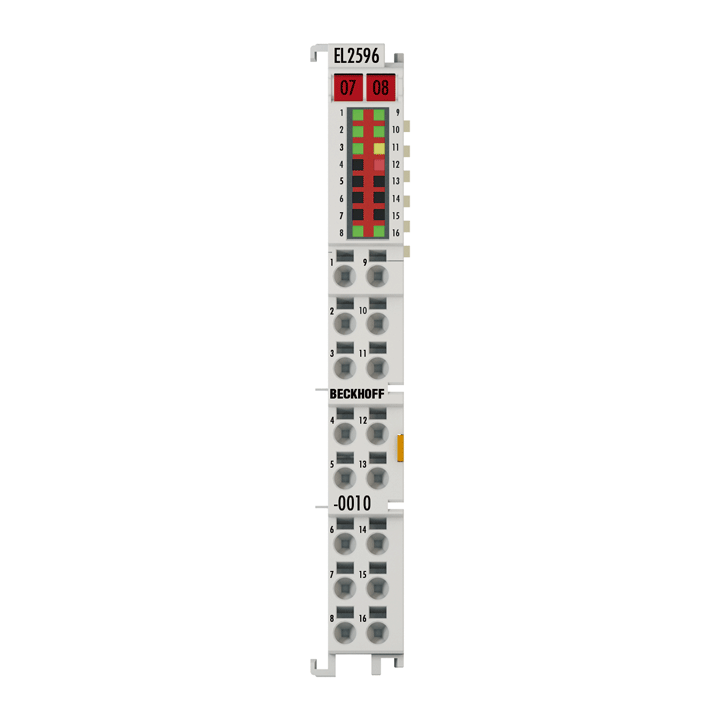
EL2596-0010 | EtherCAT Terminal, 1-channel LED output, 0…48 V DC, 3 A
The EL2596-0010 LED strobe control terminal contains a flexible power supply unit that supplies the LED with the required current and voltage. Applications from continuous light to short light pulses in the kHz range are thus possible. Each individual flash can be triggered in a controlled manner by the control system via the distributed clocks/timestamp function. The EL2596-0010 has a trigger output for triggering cameras and high-quality, fast current and voltage control, so that line scan cameras, for example, also benefit from constant illumination. Extensive real-time diagnostics, e.g. for input current/voltage and output current/voltage allow detailed monitoring of the LED light intensity. Thus, overdrive applications with short high-current pulses through the LED are possible. If a specifiable load corridor is exited, e.g., due to load errors, the EL2596-0010 switches off to protect the LED (resettable).
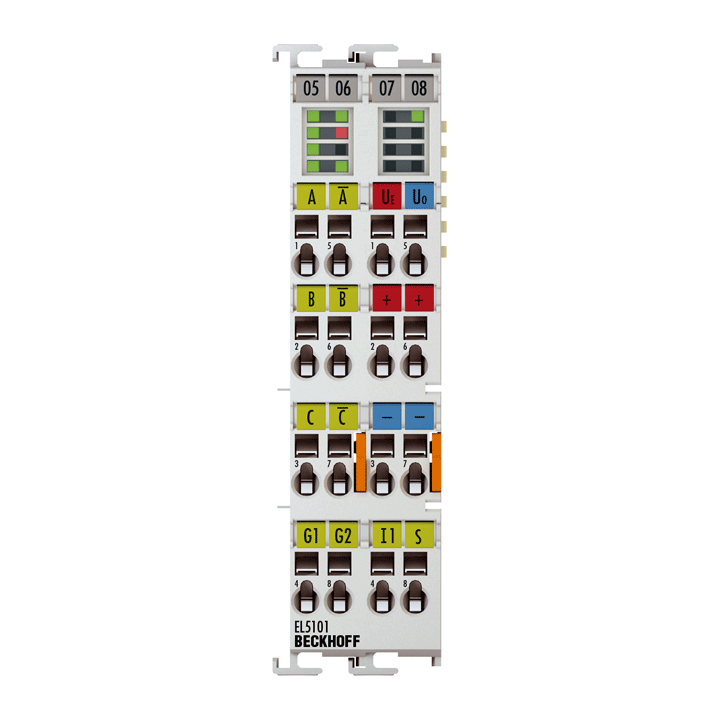
EL5101 | EtherCAT Terminal, 1-channel encoder interface, incremental, 5 V DC (DIFF RS422, TTL), 1 MHz
The EL5101 EtherCAT Terminal is an interface for the direct connection of incremental encoders with differential signals (RS422) or TTL single ended signals. Input frequencies up to 1 MHz can be evaluated. Two additional 24 V digital inputs are available for storing, blocking and setting the counter status. The error message output of an encoder can be connected and evaluated via the status input. The 5 V and 24 V supply of the encoder can be provided directly via the terminal connection points.
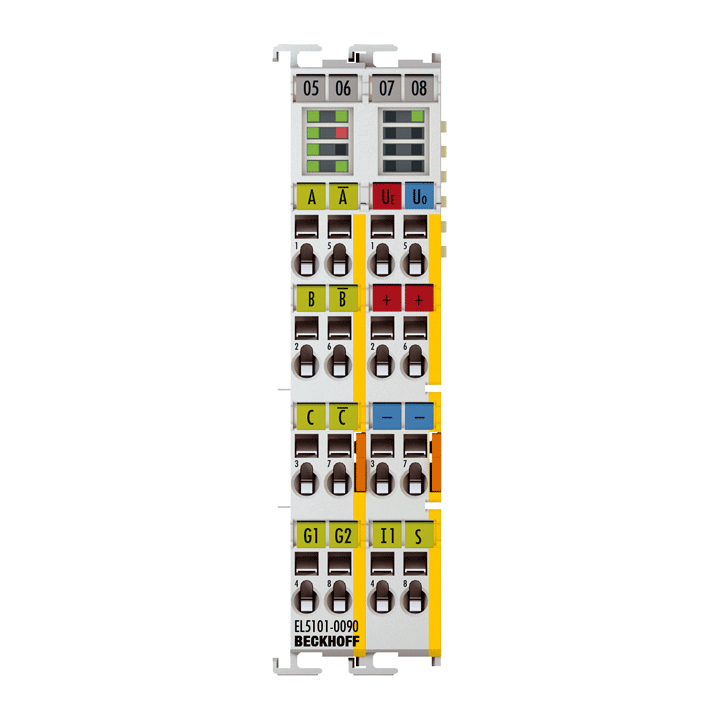
EL5101-0090 | EtherCAT Terminal, 1-channel encoder interface, incremental, 5 V DC (DIFF RS422, TTL), 1 MHz, TwinSAFE SC
The EL5101-0090 EtherCAT Terminal is an interface for the direct connection of incremental encoders with differential signals (RS422) or TTL single ended signals. Two additional 24 V digital inputs are available for storing, blocking and setting the counter status. The error message output of an encoder can be connected and evaluated via the status input. The 5 V and 24 V supply of the encoder can be provided directly via the terminal connection points.
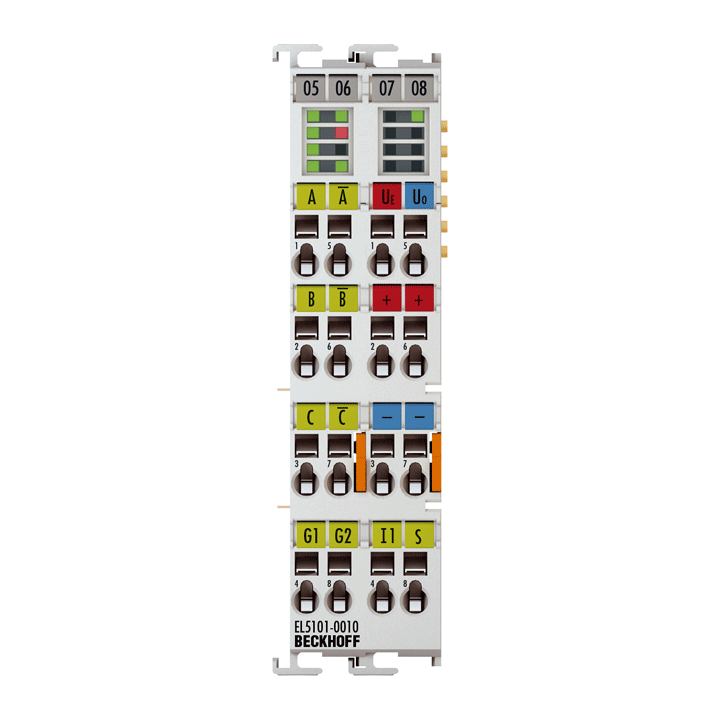
EL5101-0010 | EtherCAT Terminal, 1-channel encoder interface, incremental, 5 V DC (DIFF RS422), 5 MHz
The EL5101-0010 EtherCAT Terminal is an interface for the direct connection of incremental encoders with differential signals (RS422). With a maximum input frequency of up to 5 MHz it is particularly suitable for dynamic applications. Two additional 24 V digital inputs are available for storing, blocking and setting the counter status. The error message output of an encoder can be connected and evaluated via the status input. The 5 V and 24 V supply of the encoder can be provided directly via the terminal connection points.
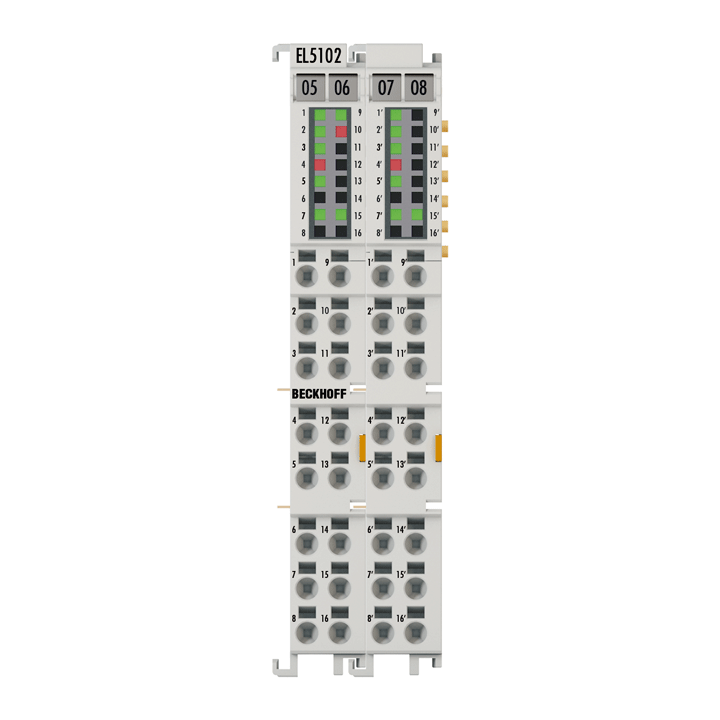
EL5102 | EtherCAT Terminal, 2-channel encoder interface, incremental, 5 V DC (DIFF RS422, TTL, open collector), 5 MHz
The EL5102 EtherCAT Terminal is an interface for the direct connection of two incremental encoders with differential signals (RS422) or single ended signals (TTL and open collector), parameterizable per channel. Input frequencies up to 5 MHz can be processed. Two additional 24 V digital inputs are available for storing, blocking and setting the counter status. It is also possible to set the counter to a predefined value or to lock the counter directly through the process data. The error message output of an encoder can be connected and evaluated via the status input. The 5 V, 12 V or 24 V supply of the encoder can be provided directly via the terminal connection points.
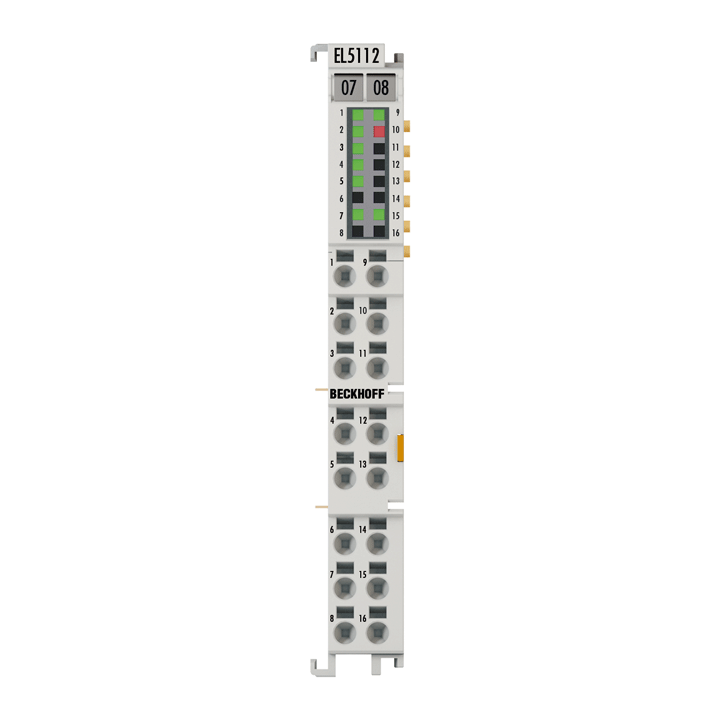
EL5112 | EtherCAT Terminal, 2-channel encoder interface, incremental, 5 V DC (DIFF RS422, TTL, open collector), 5 MHz, 2 x AB/1 x ABC
The EL5112 EtherCAT Terminal is an interface for the direct connection of two incremental encoders with A and B track or one encoder with A, B and C track. Encoders with differential signals (RS422) or single-ended signals (TTL and open collector) can be connected. Input frequencies up to 5 MHz can be processed. In 2-channel mode, one 24 V digital input per channel is available for storing, blocking and setting the counter status; in 1-channel operation, both inputs can be used. It is also possible to set the counter to a predefined value or to lock the counter directly through the process data. The 5 V, 12 V or 24 V supply of the encoder can be provided directly via the terminal connection points.
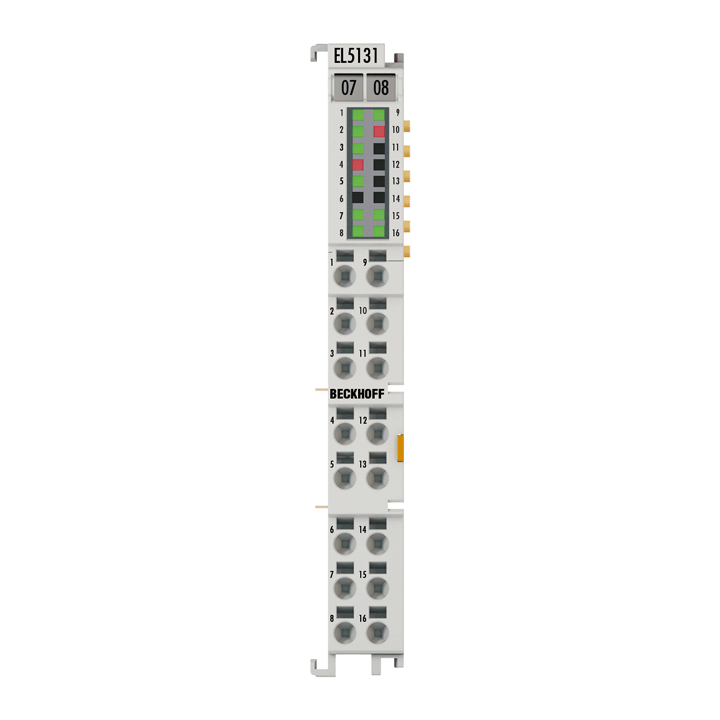
EL5131 | EtherCAT Terminal, 1-channel encoder interface, incremental, 5 V DC, 5 MHz, with 2 x digital output 24 V DC
The EL5131 EtherCAT Terminal is an interface for the direct connection of incremental encoders with differential signals (RS422) or single-ended signals (TTL and open collector). Two parameterizable 24 V DC push-pull, tristate outputs are available, which are set after reaching a specified count, frequency or speed value. This allows the realization of a digital cam controller, which uses position or time cams and ensures a precise response time independent of the fieldbus cycle.
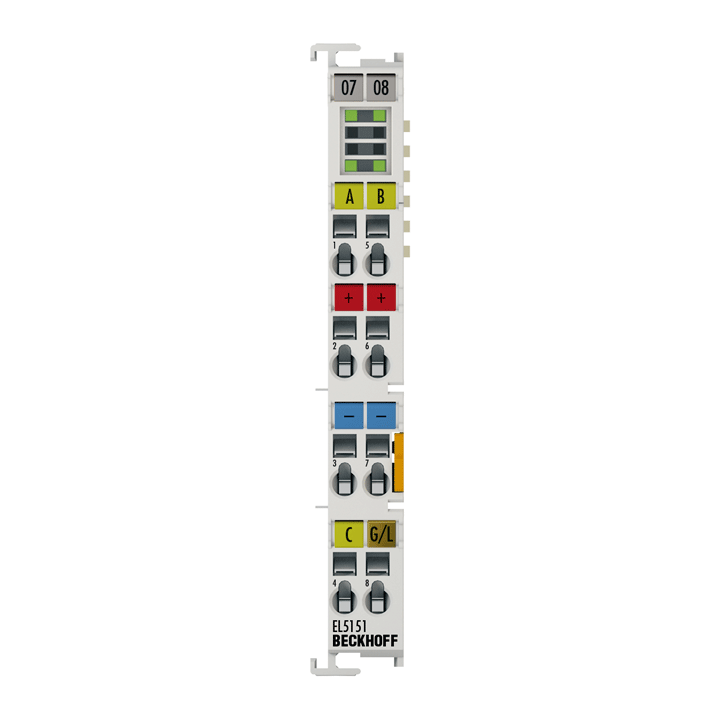
EL5151 | EtherCAT Terminal, 1-channel encoder interface, incremental, 24 V DC HTL, 100 kHz
The EL5151 EtherCAT Terminal is an interface for the direct connection of one incremental encoder (24 V HTL). An additional 24 V digital input is available for storing or blocking the counter status. As an alternative, the EL5151 can be used as a up/down counter. The 24 V supply of the encoder can be provided directly via the terminal connection points.
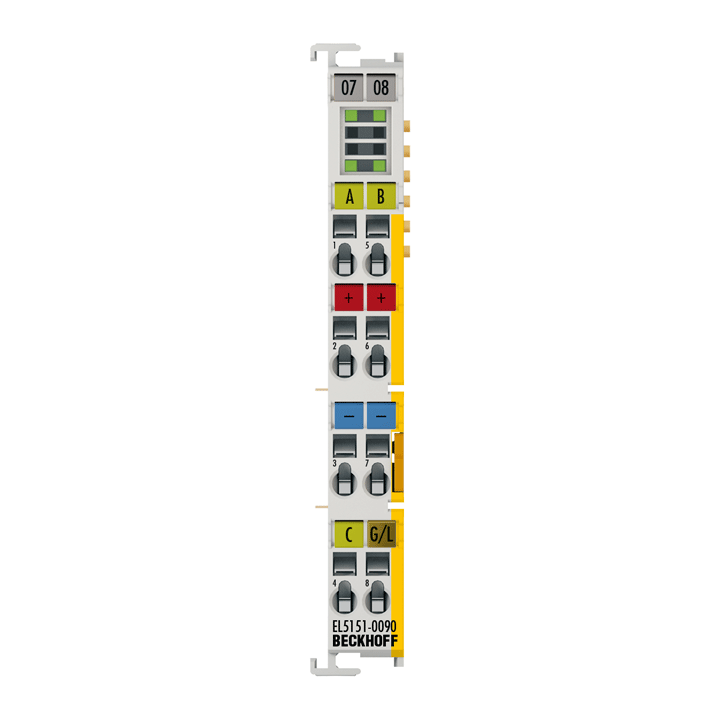
EL5151-0090 | EtherCAT Terminal, 1-channel encoder interface, incremental, 24 V DC HTL, 100 kHz, TwinSAFE SC
The EL5151-0090 EtherCAT Terminal is an interface for the direct connection of one incremental encoder (24 V HTL). An additional 24 V digital input is available for storing or blockingthe counter status. As an alternative, the EL5151-0090 can be used as a up/down counter. The 24 V supply of the encoder can be provided directly via the terminal connection points.
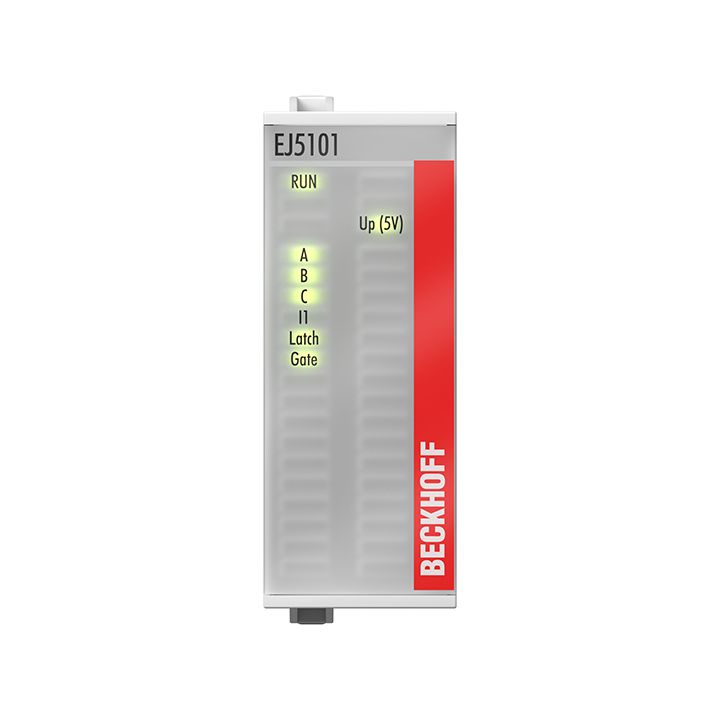
EJ5101 | EtherCAT plug-in module, 1-channel encoder interface, incremental, 5 V DC (DIFF RS422, TTL), 1 MHz
The EJ5101 EtherCAT plug-in module is an interface for the direct connection of incremental encoders with differential signals (RS422) or TTL single ended signals via the signal distribution board. Two additional 24 V digital inputs are available for storing, blocking and setting the counter status. The error message output of an encoder can be connected and evaluated via the status input of the module. The encoder can be supplied with 5 V DC directly from the EtherCAT plug-in module.
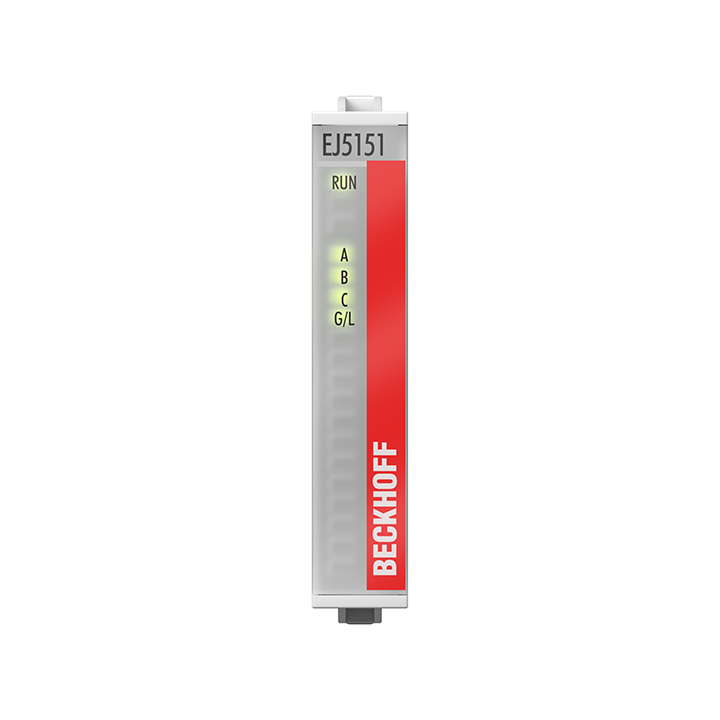
EJ5151 | EtherCAT plug-in module, 1-channel encoder interface, incremental, 24 V DC HTL, 100 kHz
The EJ5151 EtherCAT plug-in module is an interface for connecting a 24 V incremental encoder (24 V HTL) via the signal distribution board. An additional 24 V digital input is available for storing or blocking the counter reading. Alternatively, the EJ5151 can be used as up/down counter. The 24 V supply of the encoder can be provided directly via the supply on the signal distribution board.
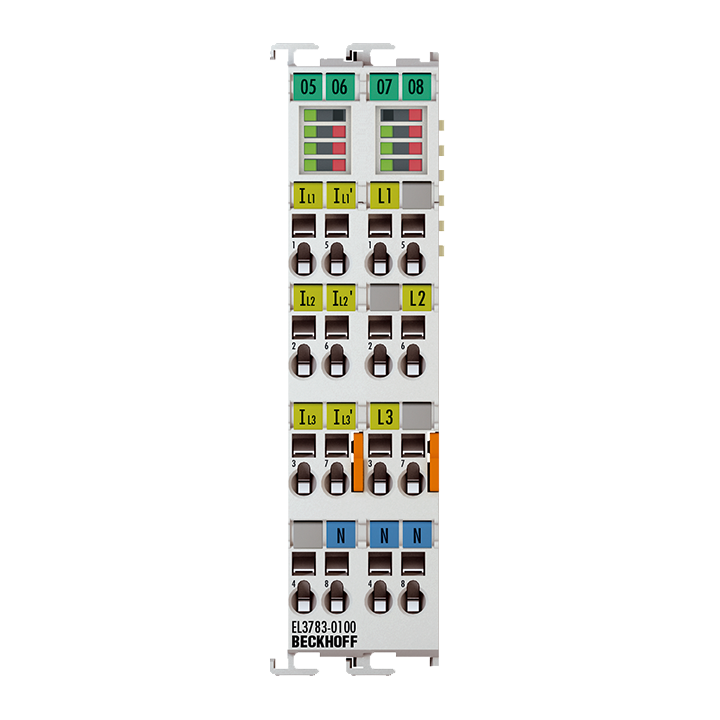
EL3783-0100 | EtherCAT Terminal, 3-channel analog input, multi-function, 130 V AC, 1/5 A, 16 bit, 20 ksps, electrically isolated, oversampling
The EL3783-0100 EtherCAT Terminal is a power monitoring I/O terminal used for state monitoring of a 3-phase AC voltage system. For each phase, voltage up to 400/690 Vrms and current up to 1 Arms/5 Arms are sampled as instantaneous values with a resolution of 16 bits. The six channels are measured simultaneously based on the EtherCAT oversampling principle with a temporal resolution of up to 50 µs and then passed on to the control system. With the processing power available there and in combination with the TwinCAT Function TF3650, true RMS or power calculations as well as complex user-specific algorithms can be calculated via the voltage and current characteristics. Through the oversampling principle, the terminal is able to measure at significantly shorter intervals than the cycle time of the control system. AC and DC parameters must be connected and measured with a common reference potential.
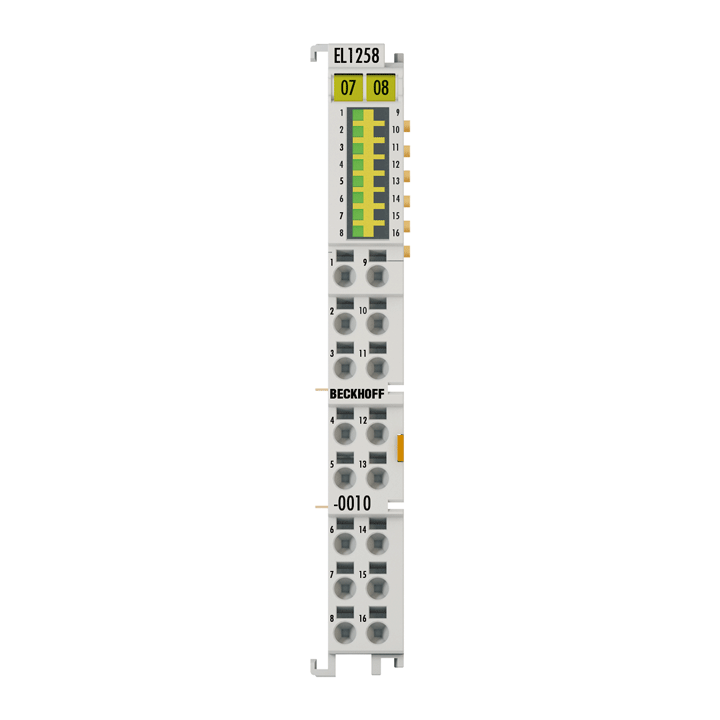
EL1258-0010 | EtherCAT Terminal, 8-channel digital input, 24 V DC, 1 µs, ground switching, multi-timestamp
The 8-channel digital input terminal EL1258-0010 acquires fast binary control signals from the process level and transmits them, in an electrically isolated form, to the controller. The EL1258-0010 is the ground switching version of the EL1258 and offers not only a higher channel density compared to the EL1252, but also higher performance due to the multi-timestamp function. Whereas the EL1252 can accept one edge change with timestamp per bus cycle, the EL1258-0010 offers the possibility to register up to 32 events with timestamps. The EL1258-0010 is synchronized with other EtherCAT devices through the distributed clocks system, so that events in the whole system can be measured with a uniform timebase.
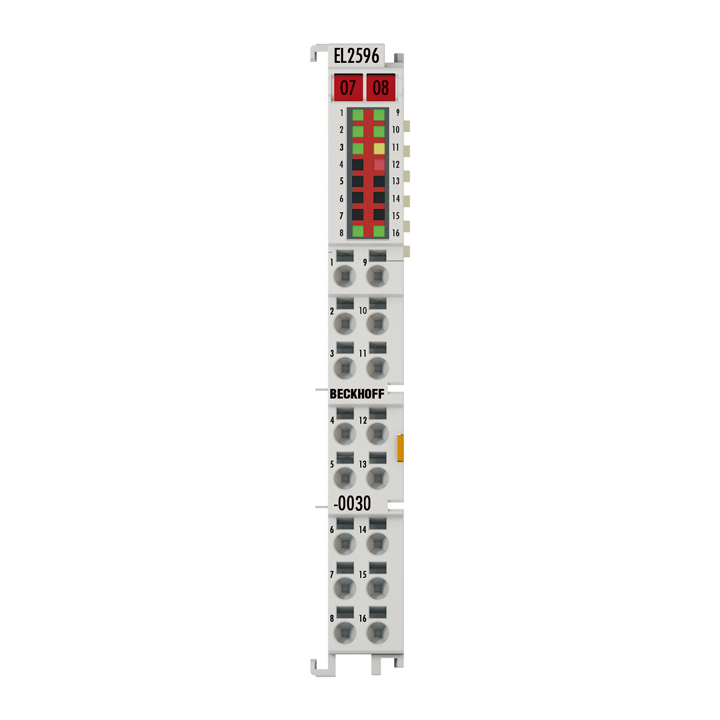
EL2596-0030 | EtherCAT Terminal, 1-channel LED output, 0…24 V DC, 3 A, externally calibrated
The EL2596-0030 LED strobe control terminal contains a flexible power supply unit that supplies the LED with the required current and voltage. Applications from continuous light to short light pulses in the kHz range are thus possible. Each individual flash can be triggered in a controlled manner by the control system via the distributed clocks/timestamp function. The EL2596-0030 has a trigger output for triggering cameras and high-quality, fast current and voltage control, so that line scan cameras, for example, also benefit from constant illumination. Extensive real-time diagnostics, e.g. for input current/voltage and output current/voltage allow detailed monitoring of the LED light intensity. Thus, overdrive applications with short high-current pulses through the LED are possible. If a specifiable load corridor is exited, e.g., due to load errors, the EL2596-0030 switches off to protect the LED (resettable).